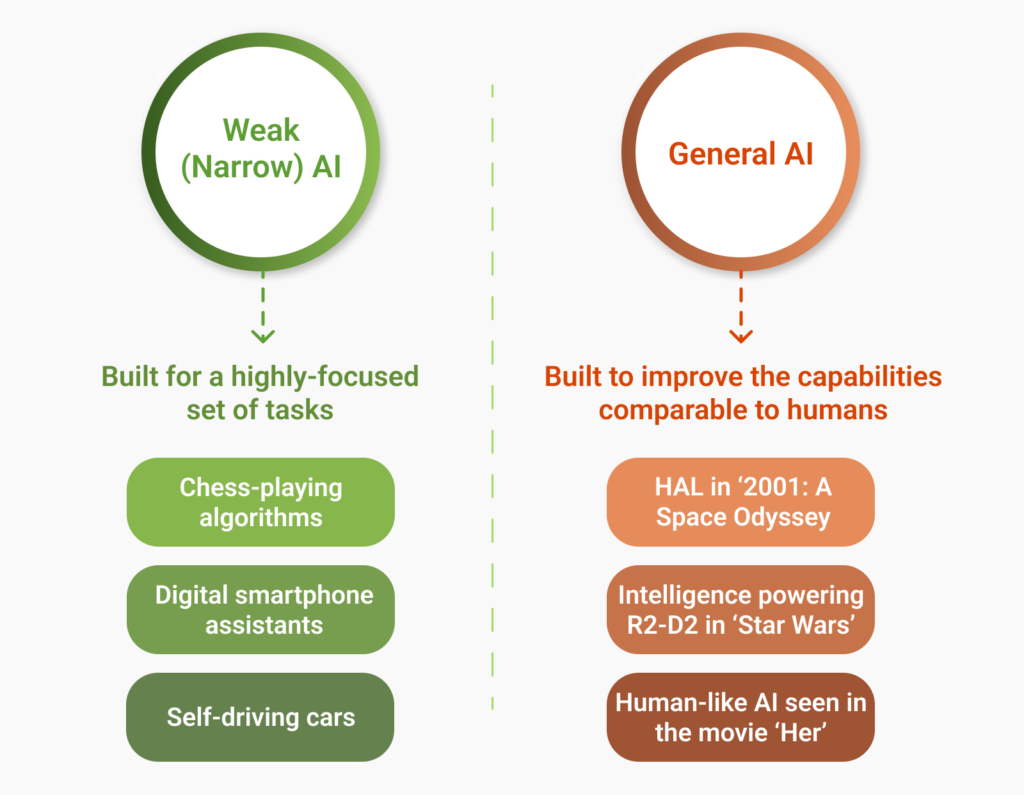Unveiling the Future of AI: Expectations vs. Reality

Ever wondered about a world where machines are super smart? They can change how industries work, and even make our daily lives easier. That’s the power of artificial intelligence (AI)!
But let’s pause for a moment. While AI holds incredible potential, it’s important to separate what’s real from what’s just hype. In this blog, we’ll take a journey together to understand the differences between what we expect AI to become and what it actually is today. So, let’s buckle up and explore the twists and turns that lie ahead in the world of AI.
The Promised Utopia: Expectations for AI
Imagine a future where machines possess intelligence that rivals our own. We want AI to become smarter than humans and be able to understand all complex concepts.
- AI revolutionizing industries: Transforming healthcare, finance, and more
One of the great expectations for AI is its ability to revolutionize industries. In healthcare, for example, AI can help diagnose diseases more accurately and develop personalized treatment plans. Similarly, in finance, AI algorithms can analyze vast amounts of data to make informed investment decisions. The potential for AI to transform various sectors and enhance productivity is truly remarkable.
- Personal AI assistants: From Jarvis to real-life virtual companions
We’ve seen fictional AI assistants like Jarvis in movies. Well, who wouldn’t want that in real life? Personal AI assistants have the potential to be our virtual helpers. They can organize our schedules, answer our questions, and even provide emotional support. The idea of having a personal AI companion is super attractive!
To sum up, our expectations for AI include achieving human-like intelligence, revolutionizing industries, personal AI assistants, and addressing ethical concerns. Let’s now explore how these expectations align with the reality of AI today.

The Unforeseen Realities: What AI Looks Like Today?
In the realm of AI, machine learning and deep learning are the driving forces. Machine learning allows AI systems to learn and improve from data, while deep learning enables them to analyze complex patterns and give accurate predictions. These techniques have helped us in areas such as image recognition, natural language processing, and recommendation systems.
Understanding AI’s current capabilities: Narrow vs. General AI
It’s important to differentiate between narrow AI and general AI.

- Narrow AI, also known as weak AI, focuses on specific tasks and performs them exceptionally well. We see narrow AI in applications like voice assistants, autonomous vehicles, and spam filters.
- On the other hand, general AI, or strong AI, refers to AI systems that possess human-level intelligence across various domains. While we’ve made remarkable progress with narrow AI, achieving general AI is still a distant goal.
AI in everyday life: Applications and impact
AI has already found its way into our daily lives in numerous ways. From personalized recommendations on streaming platforms to virtual voice assistants on our smartphones, AI is doing it all. Plus, AI’s impact extends to diverse sectors such as content marketing, healthcare, finance, transportation, and cybersecurity. It aids in medical diagnosis, fraud detection, autonomous driving, and safeguarding our digital privacy.

Limitations and challenges: Addressing bias, transparency, and trust
Despite its achievements, future AI technology faces certain limitations and challenges.
- One major concern is bias in AI systems, where they may perpetuate unfairness due to biased data or algorithmic biases.
- Transparency is another challenge, as the inner workings of some AI models remain opaque.
- Establishing trust in AI systems is crucial for wider acceptance. Building AI that is explainable, accountable, and respects privacy becomes essential to address these challenges.
AI has made its way into various aspects of our lives and industries, but there are challenges to overcome, such as bias, transparency, and trust. Let’s delve further into the future trajectory of AI, where the possibilities and complexities continue to unfold.
What is the Future of AI?

The future trajectory of AI involves breakthroughs like quantum computing and neuromorphic engineering. We are looking at human-machine collaboration, responsible AI development, and addressing social implications such as job displacement and education.
AI breakthroughs on the horizon: Quantum computing and neuromorphic engineering
The future of AI holds exciting possibilities with breakthroughs like quantum computing and neuromorphic engineering.
- Quantum computing aims to process information at an astonishing speed, enabling AI systems to solve complex problems even faster.
- Neuromorphic engineering seeks to mimic the structure and function of the human brain, potentially leading to AI systems with more efficient and adaptable learning capabilities.
Human-machine collaboration: Augmenting human abilities with AI
Rather than replacing humans, the future of AI revolves around collaboration between humans and machines. AI can augment human abilities by automating mundane tasks. It can offer valuable insights from vast amounts of data, and assist in decision-making. This partnership between humans and AI has the potential to boost productivity and creativity across various industries.
Responsible AI development: Ensuring fairness, privacy, and security
As AI advances, responsible development becomes paramount. It involves ensuring fairness, privacy, and security in AI systems.
- Fairness means preventing biases and ensuring AI treats everyone equitably.
- Privacy protection is crucial in safeguarding individuals’ personal information, while security measures are necessary to guard against cyber threats by deploying a VPN and unauthorized access to AI systems.
- Responsible future AI technology development prioritizes the ethical and responsible use of AI technology.
Social implications: Job displacement, education, and workforce adaptation
The future of AI also brings about social implications that we must address. Job displacement is a concern, as AI automation may replace certain tasks and roles. However, note that new opportunities and job roles will also emerge alongside AI advancements.
Education and the workforce need to adapt to future AI technology. This includes fostering a culture of lifelong learning and upskilling to remain resilient in the face of AI-driven changes.
Balancing Expectations and Reality: The Path Forward
1. Shaping AI policy and governance
To ensure the responsible and beneficial development of AI, all stakeholders must work together. Governments, industry leaders, researchers, and experts need to work together to establish AI policies and regulations that address ethical concerns, privacy protection, and accountability. Collaborative efforts can foster a balanced and inclusive approach to AI governance, promoting transparency and avoiding potential risks.

2. Guiding AI development and deployment
Ethics play a vital role in shaping the future of artificial intelligence. Establishing ethical frameworks helps guide the development and deployment of AI systems. These frameworks encompass principles such as fairness, accountability, transparency, and the protection of human rights. By integrating ethical considerations into AI design, we can mitigate biases, ensure AI decisions are explainable, and prioritize human well-being throughout AI’s evolution.
3. Dispelling myths and fostering understanding
Public perception of AI often includes misconceptions and fears fueled by sensationalized portrayals in media. Educating the public about AI’s capabilities, limitations, and potential benefits is a must.
By fostering understanding through accessible and accurate information, we can dispel myths and encourage informed discussions about AI. Engaging in public dialogue and education initiatives helps build trust. Hence, it ensures that AI technologies are embraced with realistic expectations.
4. Leveraging AI for a positive impact
Rather than fearing AI, we should embrace its potential for positive impact. By leveraging AI to develop innovative solutions, we can enhance sustainability, improve healthcare outcomes, and address societal inequalities. Embracing AI’s potential means harnessing its power for the collective benefit of humanity.
Let’s Embrace the Power of AI with Accountability
In this rapidly advancing world of AI, we find ourselves at the intersection of excitement and complexity. It’s essential to approach AI with an open mind, dispelling misconceptions and fostering understanding.
By embracing AI’s potential and harnessing its power responsibly, we can navigate the path ahead with confidence. Let’s seize the opportunities, address the challenges, and shape a future where AI benefits us all.
Remember, the future of AI is not predetermined, but rather a collective journey we embark on together. So, let’s stay curious, adaptable, and ethically conscious as we continue to unlock the immense potential of artificial intelligence. The possibilities are vast, and the adventure awaits!
FAQs
AI has the potential for both positive and negative impacts. While AI can bring significant benefits, such as improved efficiency and innovative solutions, it also raises concerns about job displacement, biases, and privacy. Responsible development and ethical considerations are crucial to ensure that AI is used for the greater good while minimizing harmful consequences.
AI has the potential to automate certain tasks and roles, which may lead to job displacement in some industries. However, it is important to note that AI also creates new opportunities and job roles. The impact on employment will depend on how humans adapt, upskill, and collaborate with AI technologies. The future of work will likely involve a combination of human-AI collaboration rather than complete job replacement.
Yes, AI is considered to be a significant part of our future. It has the potential to drive transformative advancements across various sectors, enhance productivity, and solve complex problems. AI technologies continue to evolve and offer new possibilities. However, it is important to approach AI development responsibly, considering ethical considerations. The future of artificial intelligence holds immense promise, but it also requires careful navigation to ensure its benefits are maximized.
Latest Blogs
Explore how Google’s 2025 AI search updates triggered ranking chaos. Learn actionable strategies to adapt your SEO for AI Overviews, zero-click searches, and SERP volatility. Stay ahead now.
Learn how to rank on AI search engines like ChatGPT, Perplexity, and Gemini by optimizing your content for authority, structure, and relevance. Stay ahead in AI-driven search with this strategic guide.
Explore the best healthcare SEO services for your medical practice. Improve online visibility and effectively reach more patients in need of your services.